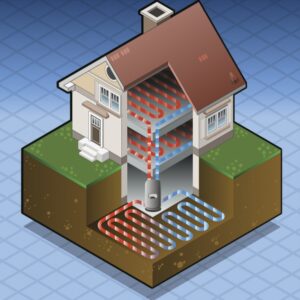More homes than ever before are discovering the advantages of geothermal heating and cooling. Geothermal heat pumps have the benefits of high energy efficiency and eco-friendliness—and like standard heat pumps, they deliver both heating and cooling.
However, if you’re asking yourself “why is my geothermal not cooling?” because the geothermal isn’t doing the job you expect from it, you may wonder if you made a bad investment. No need to worry: you can rely on our team to find out what’s wrong with your geothermal heat pump and offer the solutions that will get it back to work.
How Geothermal Systems Work
A geothermal system starts with the installation of a series of pipes buried underground known as the ground loops. These pipes are typically filled with a water-based solution of antifreeze. The ground loops absorb or release heat from the earth, depending on whether the system is in heating mode or cooling mode. Because earth remains at a relatively constant temperature at 10 feet below the frostline, typically around 50°F–60°F, the ground loops can work at greater efficiency than a standard air-source heat pump.
The rest of the components are inside the home: compressor, condenser, evaporator, and refrigerant circulation system. These indoor parts connect to the ground loop through a manifold and underground pipes.
Simple Fixes
It may simply be that your thermostat is not properly set. Ensure that it is set to the cooling mode and that the temperature is set lower than the current room temperature. This simple oversight can cause cooling problems. It’s worth double-checking the settings before proceeding further!
If that doesn’t work, next examine the power supply to the geothermal system. Verify if the system is receiving power by checking the circuit breaker or fuse. A tripped breaker or blown fuse will disrupt the system’s operation. Another simple, yet often overlooked step.
Troubleshooting More Complex Issues
Geothermal systems often use a water-to-air heat pump to provide cooling. Lack of water flow through the system can impede heat transfer, resulting in inadequate cooling. Additionally, a clogged or dirty air filter can obstruct airflow, reducing the cooling capacity of your geothermal system.
The ground loop is a critical component, responsible for heat exchange with the earth. Inadequate design or installation of the ground loop can hinder the system’s ability to extract heat from the indoors for cooling purposes. It could also be a leak. geothermal systems that use refrigerants, such as water-to-air heat pumps, may experience cooling problems due to refrigerant leaks.
Finally, cooling problems can be attributed to faulty components within the system. A malfunctioning compressor, fan motor, or thermostat could disrupt the cooling process. If you suspect a faulty component, contact a professional Bartels Heating & Cooling technician!
When your geothermal system fails to provide cooling, it’s essential to give Bartels Heating & Cooling a call! We’re dedicated to serving all of your heating and air conditioning needs and provide professional, timely service throughout Hamilton, OH.
Don’t compromise, use the best! Contact Bartels Heating & Cooling today for your appointment!

